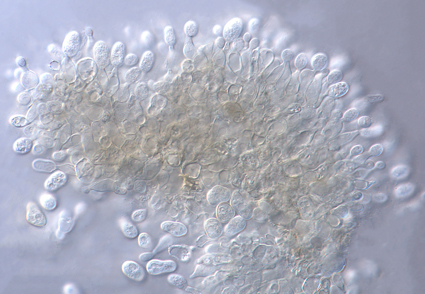Abstract
During a survey of microfungi on symptomatic leaves from Photinia serratifolia (Desfontaines) Kalkman, an interesting species of asexual ascomycetes were found. Based on multilocus phylogenies from a combined dataset of genes encoding internal transcribed spacer (ITS), large subunit of ribosomal RNA (LSU), translation elongation factor 1 alpha (tef1), part of the beta-tubulin gene region (tub2), and partial RNA polymerase II second largest subunit (rpb2), in conjunction with morphological characteristics, we describe a new genus of Tubakiaceae, Ellipsoidisporodochium gen. nov. (type species: Ellipsoidisporodochium photiniae sp. nov.). The genus has fusoid to ampulliform sporodochia and obovoid to ellipsoid conidia. Their relatedness to allied taxa are also annotated and discussed.
References
Carbone, I. & Kohn, L.M. (1999) A method for designing primer sets for speciation studies in filamentous ascomycetes. Mycologia 91 (3): 553–556. https://doi.org/10.1080/00275514.1999.12061051
Fan, X.L., Bezerra, J.D.P., Tian, C.M. & Crous, P.W. (2018) Families and genera of diaporthalean fungi associated with canker and dieback of tree hosts. Persoonia 40: 119–134. https://doi.org/10.3767/persoonia.2018.40.05
Glass, N.L. & Donaldson, G.C. (1995) Development of primer sets designed for use with the PCR to amplify conserved genes from filamentous ascomycetes. Applied and Environmental Microbiology 61 (4): 1323–1330. https://doi.org/10.1128/AEM.61.4.1323-1330.1995
Gao, Y.H., Sun, W., Su, Y.Y. & Cai, L. (2014) Three new species of Phomopsis in Gutianshan Nature Reserve in China. Mycological Progress 13 (1): 111–121. https://doi.org/10.1007/s11557-013-0898-2
Guo, L.D., Hyde, K.D. & Liew, E.C.Y. (2000) Identification of endophytic fungi from Livistona chinensis based on morphology and rDNA sequences. New Phytologist 147 (3): 617–630. https://doi.org/10.1046/j.1469-8137.2000.00716.x
Huelsenbeck, J.P. & Ronquist, F. (2001) MRBAYES: Bayesian inference of phylogeny. Bioinformatics 17 (17): 754–755. https://doi.org/10.1093/bioinformatics/17.8.754
Katoh, K., Rozewicki, J. & Yamada, K.D. (2019) MAFFT online service: multiple sequence alignment, interactive sequence choice and visualization. Briefings in Bioinformatics 20: 1160–1166. https://doi.org/10.1093/bib/bbx108
Kumar, S., Stecher, G. & Tamura, K. (2016) MEGA7: Molecular Evolutionary Genetics Analysis Version 7.0 for Bigger Datasets. Molecular Biology and Evolution 33 (7): 1870–1874. https://doi.org/10.1093/molbev/msw054
Liu, Y.J., Whelen, S. & Hall, B.D. (1999) Phylogenetic Relationships among Ascomycetes: evidence from an RNA polymerse II subunit. Molecular Biology and Evolution 16 (12): 1799–1808. https://doi.org/10.1093/oxfordjournals.molbev.a026092
Miller, M.A., Pfeiffer, W. & Schwartz, T. (2012) The CIPRES science gateway: enabling high-impact science for phylogenetics researchers with limited resources. In: Proceedings of the 1st Conference of the Extreme Science and Engineering Discovery Environment. Bridging from the extreme to the campus and beyond. Association for Computing Machinery, USA, pp. 1–8. https://doi.org/10.1145/2335755.2335836
Nylander, J.A.A. (2004) MrModelTest v. 2. Program distributed by the author. Evolutionary Biology Centre, Uppsala University.
O’Donnell, K., Kistler, H.C., Cigelnik, E. & Ploetz, R.C. (1998) Multiple Evolutionary Origins of the Fungus Causing Panama Disease of Banana: Concordant Evidence from Nuclear and Mitochondrial Gene Genealogies. Proceedings of the National Academy of Sciences of the United States of America 95 (5): 2044–2049. https://doi.org/10.1073/pnas.95.5.2044
Rehner, S.A. & Samuels, G.J. (1994) Taxonomy and phylogeny of Gliocladium analysed from nuclear large subunit ribosomal DNA sequences. Mycological Research 98 (6): 625–634. https://doi.org/10.1016/S0953-7562(09)80409-7
Ronquist, F. & Huelsenbeck, J.P. (2003) MrBayes 3: Bayesian Phylogenetic Inference under Mixed Models. Bioinformatics 19 (12): 1572–1574. https://doi.org/10.1093/bioinformatics/btg180
Ronquist, F., Teslenko, M., van der Mark, P., Ayres, D.L., Darling, A., Höhna, S., Larget, B., Liu, L., Suchard, M.A. & Huelsenbeck, J.P. (2012) MrBayes 3.2: efficient Bayesian phylogenetic inference and model choice across a large model space. Systematic Biology 61 (3): 539–542. https://doi.org/10.1093/sysbio/sys029
Senanayake, I.C., Crous, P.W., Groenewald, J.Z., Maharachchikumbura, S.S.N., Jeewon, R., Phillips, A.J.L., Bhat, J.D., Perera, R.H., Li, Q.R., Li, W.J., Tangthirasunun, N., Norphanphoun, C., Karunarathna, S.C., Camporesi, E., Manawasighe, I.S., Al-Sadi, A.M. & Hyde, K.D. (2017) Families of Diaporthales based on morphological and phylogenetic evidence. Studies in Mycology 86: 217–296. https://doi.org/10.1016/j.simyco.2017.07.003
Stamatakis, A. (2014) RAxML Version 8: a tool for phylogenetic analysis and post-analysis of large phylogenies. Bioinformatics 30 (9): 1312–1313. https://doi.org/10.1093/bioinformatics/btu033
Sung, G.H., Sung, J.M., Hywel-Jones, N.L. & Spatafora, J.W. (2007) A multi-gene phylogeny of Clavicipitaceae (Ascomycota, Fungi): identification of localized incongruence using a combinational bootstrap approach. Molecular Phylogenetics and Evolution 44 (3): 1204–1223. https://doi.org/10.1016/J.YMPEV.2007.03.011
Vilgalys, R. & Hester, M. (1990) Rapid genetic identification and mapping of enzymatically amplified ribosomal DNA from several Cryptococcus species. Journal of Bacteriology 172 (8): 4238–4246. https://doi.org/10.1128/JB.172.8.4238-4246.1990
White, T.J., Bruns, T., Lee, S. & Taylor, J. (1990) Amplification and direct sequencing of fungal ribosomal RNA genes for phylogenetics. In: Innis, M.A., Gelfand, D.H., Sninsky, J.J. & White, T.J. (Eds.) PCR Protocols: a guide to methods and applications. Academic Press, San Diego, pp. 315–322. https://doi.org/10.1016/B978-0-12-372180-8.50042-1
Zhang, Z., Schwartz, S., Wagner, L. & Miller, W. (2000) A greedy algorithm for aligning DNA sequences. Journal of Computational Biology 7: 203–214. https://doi.org/10.1089/10665270050081478
Zhang, Z.X., Mu, T.C., Liu, S.B., Liu, R.Y., Zhang, X.G. & Xia, J.W. (2021) Morphological and phylogenetic analyses reveal a new genus and two new species of Tubakiaceae from China. Mycokeys 84: 185–201. https://doi.org/10.3897/mycokeys.84.73940


